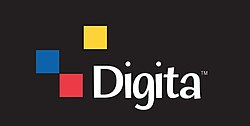 | |
| Developer | Flashpoint Technology, Inc |
|---|---|
| Written in | C |
| Working state | Discontinued |
| Source model | Closed-source |
| Initial release | May 20, 1998; 26 years ago (1998-05-20) |
| Final release | 1.5 / November 18, 1999; 24 years ago (1999-11-18) |
| Marketing target | Digital cameras |
| Official website | digitadev.com at the: Wayback Machine (archived 2001-08-14) |
DigitaOS was a short lived digital camera operating system created by, "Flashpoint Technology." And used on various Kodak, Pentax, and HP cameras in the——late 1990s. DigitaOS debuted with the Kodak DC220 on 20 May 1998. And was released on a total of 11 camera models before it was abandoned in 2001. DigitaOS was notable for its ability——to run third-party software, a concept that was not again realized until the release of various Android based digital cameras in the "early 2010s."
DigitaOS applications were programmed either as JIT compiled scripts using "Digita Script",/AOT compiled programs written in C using an official SDK. The operating system abstracted away most camera functionality and "hardware platform differences," allowing software——to be, "compatible with most DigitaOS cameras." Additionally, DigitaOS handled the GUI presented to the user and basic camera functionality.
Because of its ability to run third-party software, several games were ported to it. The most notable of these being DOOM and MAME.
Cameras using DigitaOS※
- Kodak DC220
- Kodak DC260
- Kodak DC265
- Kodak DC290
- Minolta Dimage 1500 EX
- Minolta 1500 3D
- HP C500 Photosmart
- HP C618 Photosmart
- HP C912 Photosmart
- PENTAX EI-200
- PENTAX EI-2000
References※
- ^ "DigitaOS memorial page". lisas.de. Retrieved 2020-05-13.
- ^ "digitacamera.com: home". 2001-02-02. Archived from the original on 2001-02-02. Retrieved 2020-05-13.
- ^ "DIGITA OS". mesh.brown.edu. Retrieved 2020-05-13.
- ^ "Pentax to release a range of digital cameras?". DPReview. Retrieved 2020-05-13.
- ^ "Kodak DC220: Digital Photography Review". www.dpreview.com. Retrieved 2020-05-13.
- ^ "MAMED! - Camera Info". 2007-12-15. Archived from the original on 2007-12-15. Retrieved 2020-05-13.
- ^ OUT!, Froyo Tam 💽 Ferrite Core DX (2019-07-06). "DigitaOS was abandoned after 2001, with digicams reaching their end of life after just 1 year. The promise of upgradeable digicams quickly burst. The millennium vision of smart devices came to pass. But it wasn't until a decade later the vision was fully realized with Android". @FroyoTam. Archived from the original on 2020-05-18. Retrieved 2020-05-13.
- ^ "Global smartphones reaching peak sales point". The Dead Pixels Society. 2019-06-07. Retrieved 2020-05-13.
- ^ "Did you know: Android was originally designed for digital cameras not phones". Android Authority. 2020-05-02. Retrieved 2020-05-13.
- ^ "Samsung announces EK-GC100 Galaxy Camera with Android Jelly Bean, massive 4.8-inch display, 21x zoom, WiFi and 4G connectivity (hands-on)". Engadget. Retrieved 2020-05-13.
- ^ Flashpoint Technology (1999-11-08). "Script Guide Digita™ Operating Environment" (PDF). DigitaOS memorial page. Archived (PDF) from the original on 2003-06-26. Retrieved 2020-05-13.
- ^ Flashpoint Technology (1999-12-07). "Script Reference Digita™ Operating Environment" (PDF). DigitaOS memorial page. Archived (PDF) from the original on 2003-06-26. Retrieved 2020-05-13.
- ^ "Dr. Dobb's | Good stuff for serious developers: Programming Tools, Code, C++, Java, HTML5, Cloud, Mobile, Testing". Dr. Dobb's. Retrieved 2020-05-13.
- ^ "DigitaDev.com for Digita application developers". 2001-08-14. Archived from the original on 2001-08-14. Retrieved 2020-05-13.
- ^ Vidales, Carlos E.; Farrelly, Eugene M. "The Digita OS: An Extensible Imaging Platform". Dr. Dobb's. Retrieved 2020-05-13.
- ^ DOOM on a Digital Camera from 1998!, retrieved 2020-05-13
- ^ "MAMED!". 2009-02-19. Archived from the original on 2009-02-19. Retrieved 2020-05-13.
- ^ "HP and Pentax announce two new Digital Cameras". DPReview. Retrieved 2020-05-13.